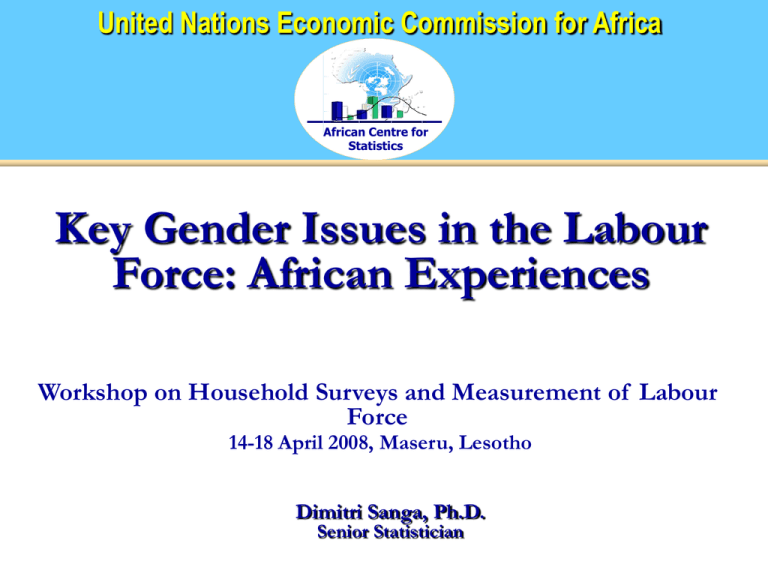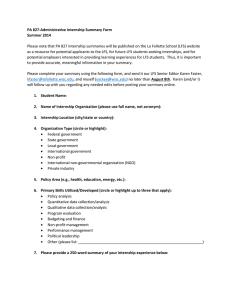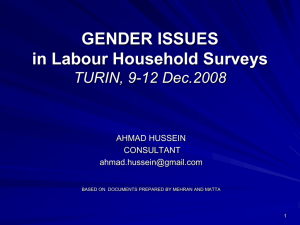Key Gender Issues in the Labour Force: African Experiences
advertisement

United Nations Economic Commission for Africa African Centre for Statistics Key Gender Issues in the Labour Force: African Experiences Workshop on Household Surveys and Measurement of Labour Force 14-18 April 2008, Maseru, Lesotho Dimitri Sanga, Ph.D. Senior Statistician Outline Labour force surveys The need for engendering labour force surveys Key gender issues emerging from selected African labour force surveys Mainstreaming gender into labour force surveys Conclusions 2 Labour force surveys 3 Objectives Overall objective: Collect information on the characteristics of employment and the distribution of the population based on their position in the labour market 4 Main categories Population of a given age group Active Employed Inactive Unemployed 5 Information Keeps track of the labour market and the economy in general Provides regular information on indicators: Activity rate Average work schedule Proportion of temporary/permanent jobs Proportion of part/full time jobs Unemployment rate 6 Information(Cont’d) May provide information on: Sector: public sector and private enterprises Socio-professional category: employee, family helper, head of an enterprise… Others: employment contract, access to social security, the right to paid leave, sick leave, etc Employment characteristics can be used to: Identify those who are in the informal economy Those who belong to an informal production unit Those holding an informal job in a formal enterprise or in a household 7 Labour force surveys in Africa LFS in developed and medium-income countries: on an infra-annual basis In Africa: Some LFS Equivalent tools: employment surveys or employment segment of household surveys Frequency may be non-defined (because the operation may depend on external financing) In some countries: frequency is at best annual 8 The need for engendering labour force surveys 9 The case for engendered LFS Engendered labour force surveys like other statistical operations help: Conduct unbiased evidence-based policy formulation and decision making Address issues of inequalities and empowerment of women Raise consciousness, persuade policy makers and other stakeholders to take into account the gender dimension in policy formulation and decision making processes 10 Key gender issues emerging from selected African LFS 11 Ethiopia 12 Activity rate by age and sex Whatever the age group: women are less active than men Activity Rate 65+ 35.13 73.38 58.65 60 - 64 92.82 73.76 55 - 59 96.07 77.6 50 - 54 95.28 85.33 45 - 49 86.59 40 - 44 84.46 35 - 39 30 - 34 85.77 25 - 29 85.62 81.9 20 - 24 97.67 98.1 97.87 97.76 95.91 88.7 69.07 73.16 15 - 19 54.47 10-14 66.57 73.46 All ages Male Source: Ethiopian LFS, 10+ 84.75 Female 13 Employment to population ratio 100 90 80 70 60 % 50 40 30 20 Male Female 10 0 10 - 14 15 - 19 20 - 24 25 - 29 Male 70.1 73.2 86.4 Female 53.4 62.7 73.8 30 - 34 35 - 39 40 - 44 45 - 49 93 96.4 96.5 97.8 78.2 80.2 79.1 82.5 50 - 54 55 - 59 60 - 64 65+ 97.3 95.5 94.5 92.8 75.2 81.2 76.4 72.9 61 38.9 Source: Ethiopian LFS, Men are more employed than women in all age groups 14 Employment rates by age group and sex 120 100 Percentage 80 60 40 20 0 All ages 10-14 15 - 19 20 - 24 25 - 29 30 - 34 35 - 39 Male 40 - 44 45 - 49 50 - 54 55 - 59 60 - 64 65+ Female Source: Ethiopia LFS 2005 (10+) 15 Employment by industry and sex 16,000,000 Some industries are female dominated while others are male dominated 14,000,000 12,000,000 10,000,000 8,000,000 6,000,000 4,000,000 2,000,000 0 Agriculture, Hunting Forestry & Fishing Manufacturing Male Female Whole sale & Retail Trade,Repair of Vehicles,Personal & Household goods Source: Ethiopian LFS, 2005 (10+) 16 Employment in formal/informal sector 1,400,000 Men are mainly employed in the formal sector while female dominate the informal sector 1,200,000 1,000,000 800,000 600,000 400,000 200,000 0 Formal sector Informal sector Not Identified Male 1,189,349 563,664 8,935 Female 629,966 761,517 2,364 Source: Ethiopian LFS, 2005 (10+) 17 Unemployment vs. literacy 700,000 600,000 500,000 400,000 300,000 200,000 100,000 0 All Illiterate All Literate Male Female Source: Ethiopian LFS, 2005 (10+) 18 Unemployment vs. Education level 350,000 300,000 250,000 200,000 150,000 100,000 50,000 0 Male Female Source: Ethiopian LFS, 2005 (10+) 19 Current female employment by marital status 50 45 40 35 30 25 20 15 10 5 0 Married/Living together Divorced/Separated/Widowed Never married Source: Ethiopian LFS, 2005 (10+) 20 Zambia 21 Proportion of currently unemployed population by sex and age group 30 25 Percentage 20 15 10 5 0 All Zambia 15-19 20-24 25-29 30-34 35-39 40-44 45-49 50-54 55-59 60-64 65+ Age-Group Male Female Source: Zambia LFS 2005 (15+) 22 Unemployment by education level 30 25 Percentage 20 15 10 5 0 Grade 1-7 Grade 8-9 Grade 10-12 Male A Level Degree Female Source: Zambia LFS 2005 (15+) 23 Distribution of employment by occupation and sex Service Production and related Agriculture, forestry and fisheries Sales Clerical and related Professional, technical and related Administrative, managerial 0 10 20 30 40 50 60 70 80 Percentage Female Male Source: Zambia LFS 2005 (15+) 24 Distribution of employment by status 60 53 51 50 40 Percentage 34 30 26 22 20 12 10 1 1 0 Self-Employed Employer Paid Employee Male Unpaid Family Worker Female Source: Zambia LFS 2005 (15+) 25 Informal/formal sector •The proportion of informal sector employees is higher among females than males 94 100 83 90 80 70 60 50 40 30 20 17 6 10 Male 0 Formal Informal Female •More jobs in the informal sector than in the formal sector Source: Zambia LFS 2005 (15+) 26 Employment in the informal sector by industry and sex 120 100 Percentage 80 60 40 20 0 Male Source: Zambia LFS 2005 (15+) Female 27 Employment status in the informal sector by sex 80 70 60 Percentage 50 40 30 20 10 0 Self Employed Employer Paid Employee Male Unpaid Family Worker Other Status Female Source: Zambia LFS 2005 (15+) 28 Employment status in the informal sector 80 70 60 50 40 30 20 10 0 Employer Paid Employee Male Female Unpaid Family Worker Other Status Source: Zambia LFS 2005 (15+) Women are mainly unpaid family workers in the informal sector 29 Economically active population 80 70 60 50 40 30 20 10 0 Grade 1-7 Grade 8-9 Grade 10-12 A level Degree Ma le Fe ma le Source: Zambia LFS 2005 (15+) Primary education: no imbalance Above primary education: more are more likely to be active 30 Mainstreaming gender into LFS 31 Different stages of the survey Gender issues should be taken into account at different stages of the survey: Planning and design Methodology Data collection and processing Data analysis and dissemination 32 Planning and design Study the societal needs in data on the labour force Selection of topics: Should reflect ways in which men and women view, perform, control, benefit from their work activities Coverage: As many topics and types of productive activities Work in widest sense, working time Job-seeking behaviour Moonlighting or combined activities Casual work, subsistence Informal employment 33 Methodology Concepts and definitions: Employment: does it include or not women in long maternity leave? Head of he household: is it always a man? Questionnaire design: Adequate detail: on pots occupied by the respondent Formulation: avoid biased questions: Do you work? (interpreted as formal sector) Are you engaged in any work paid in money or in kind? Do you sell products on the street or at the market? Type and place of work Reflect income components (salaries, benefits, overtime…) 34 Data collection and processing Training of statistician and field staff: an good understanding of gender sensitive statistics Respondent’s choice (proxy or not) Unit: household or individual? Treatment of the collected information: Imputation methods should take into account the gender perspective Missing values 35 Data analysis and dissemination Use effectively gender blind data through appropriate data analysis Have a tabulation policy in support of gender sensitive analysis Relevant dissagregation: By sex (a minimum) Marital status Family/personal characteristics Job characteristics Family context Personal circumstances Gender statistics database 36 Conclusions There is a need to engender statistical processes including LFS Mainstreaming gender into LFS should be done at every step of the survey process There is a need for sensitisation of survey statisticians through training 37 Thank you! African Centre for Statistics Visit us at http:www.uneca.org/statistics/ 38




